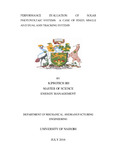| dc.contributor.author | Kiprotich, Bii | |
| dc.date.accessioned | 2016-11-18T07:33:15Z | |
| dc.date.available | 2016-11-18T07:33:15Z | |
| dc.date.issued | 2016 | |
| dc.identifier.uri | http://hdl.handle.net/11295/97533 | |
| dc.description.abstract | Solar energy is a clean and naturally available source of energy. Its exploitation has been
hampered by the low conversion efficiency of PV panels. This research investigates the technical
and economic benefits of two modes solar tracking systems that is, single axis and dual axis
tracking systems. The additional energy achieved by solar tracking is compared to energy
harnessed from a solar PV operating in a fixed platform. The objective of this work is to quantify
the benefits of solar tracking systems and give a verdict on its importance in the solar PV
industry. Computer simulation of a 1 MW solar PV plant installed at latitude -1.3˚ and longitude
36.75˚ operating under three modes of operation was performed and it was discovered that dual
axis is the most attractive in terms of energy yield and fixed axis mode was the least attractive in
terms of energy yield. When the economic analysis was carried out using the Net Present Value
approach, when the cost of land was wholly subsidized by the government then single axis
tracking was the most economically viable followed by fixed axis and dual axis was the least
economically viable. In absence of land subsidiesfixed axis became the most economically
viable followed by single axis and dual axis was the least viable option. The maximum threshold
in the cost of land per acre beyond which it is not economically viable to invest in the PV plant
for this area of study is USD 190592, USD 91236 and USD 98170 respectively for single axis,
fixed axis and dual axis tracking. It was concluded that full benefits of tracking could be realized
in this area of study if the cost of land is subsidized and Balance of System (BOS) is low.
Tracking is also beneficial when the irradiance level is high. In the area of study it was more
beneficial to incorporate tracking in the months of December, January and February in relation to
other months. From historical data, these are the hottest months in a typical meteorological year
in Nairobi. | en_US |
| dc.language.iso | en | en_US |
| dc.publisher | University of Nairobi | en_US |
| dc.rights | Attribution-NonCommercial-NoDerivs 3.0 United States | * |
| dc.rights.uri | http://creativecommons.org/licenses/by-nc-nd/3.0/us/ | * |
| dc.title | Performance evaluation of solar Photovoltaic systems: a case of fixed, single and dual axis tracking systems | en_US |
| dc.type | Thesis | en_US |



